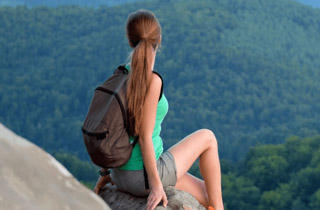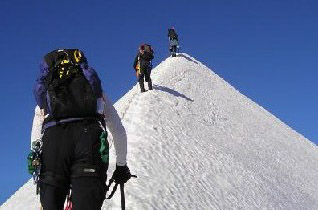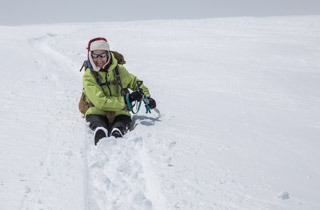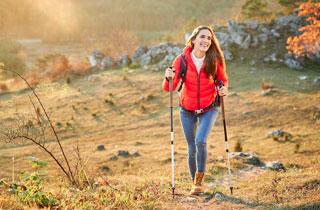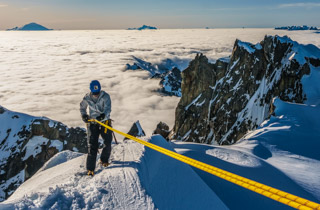Hiking Program Design
Hiking Program Design
Preparation for hiking involves training for specific fitness qualities, going on sport-specific outings, and practicing skills necessary for the sport.
The four major fitness components to include in a program for hiking include:
- Aerobic Endurance
- Anaerobic Endurance (for high altitude)
- Lower Body and Core Strength and Balance
- Flexibility and Mobility
Explore hiking program design and nutrition requirements in these suggested articles.
How can taking a five-minute action help? It creates a tiny bit of positive momentum that helps you get unstuck. You’re probably thinking, “But clutter-busting my house will take weeks, maybe even months.” Or maybe, “That’s ridiculous. I can’t prepare to climb Mt. Rainier in five minutes.” And trust me, I’ve said it myself: “There’s no way I can even think about writing a book in five minutes.”
I hear you.
BUT… what five-minute action COULD you take that will get you one step closer to your goal?
Let’s use this article as an example. It was once on my “shortlist”, but it was not my “one thing.” Until the day it became the ONE THING I had to do. Yet, I still couldn’t get started.
Finally, I reminded myself to pick a five-minute task. It could be anything. I chose to look for some photographs to go with my blog post.
Before I knew it, I had chosen pictures that represented different aspects of taking a five-minute action. Then, I came up with several headings. I wrote my first paragraph. And an ending. Before long, I had written half the blog. All it took was committing to taking one five-minute action.
If you feel stuck with your workouts, or you struggle to make any gains despite herculean efforts, check your overall volume of activity and the quality of your sleep. Rest and recovery play an enormous role in performance as well as in injury recovery. Most adults don’t seem to get enough sleep.
What are some indicators of overtraining? The following behavioral indicators are your body’s way of making further increases in stress volume and performance improvement nearly impossible:
- Apathy
- Changes in sleep patterns
- Decreased libido
- Increased thirst or sugar cravings (beyond the norm)
- Lethargy or sluggishness
- Loss of ability to concentrate
- Unexplained irritability
Our bodies are remarkably intelligent. Can you tune into what your body is telling you?
Physical indicators include:
- Change in resting heart rate
- Diarrhea
- Fatigue or muscle soreness beyond DOMS (Delayed Onset Muscle Soreness)
- Infection
- Injury
- Lymph gland swelling
- Reduced performance (slowed times, weaker on climbs or lifts),
- Slow-healing wounds
- Unusual weight fluctuation
None of these is a “sure” indicator. However, if you have several at one time, your body may be asking for rest.
Mindfulness has become a popular practice in yoga and therapies, but it also has its place in the mountains. To be “mindful” means paying complete attention to what’s going on, both inside your head and outside of yourself, and being fully present at the moment. If you are multi-tasking, you are likely not being mindful. Likewise, if you are rushing to get things done or tag the summit and get back to the car, you probably don’t have a good chance of being mindful. The other component of mindfulness is accepting yourself exactly as you are, or treating yourself the way you would treat a good friend. The next time you’re out in the wilderness see if any of these mindfulness tips help bring you back to the present moment.
Diets are as individualized as our fingerprints. Stores offer hundreds, if not thousands, of diet books. You may have even tried dozens of strategies yourself. By adhering to the following six tried-and-true principles you can make long-term progress with your health.
Eat Whole Foods Instead of Processed
As food processing increases, nutrient density decreases. Typically, the greater the degree of processing, the higher the likelihood that a food:
Has lost nutritional value, such as fiber, essential fatty acids, vitamins, minerals, and phytonutrients.
Has gained additives, preservatives, fillers, sugar, sodium, unhealthy fats, and/or refined starch.
Will leave you less satisfied and could encourage over-consumption
Eat Protein with Every Meal
Without adequate protein, our bodies can’t function properly. We need amino acids (protein’s building blocks) to produce important molecules like enzymes, hormones, neurotransmitters, and antibodies.
Protein absorption varies widely. An important thing to consider is the source. Animal proteins tend to be absorbed more easily by the body. If you are trying to get protein from plant sources, you will likely need a larger amount in order to absorb the same nutrients.
Muscle mass correlates strongly with longevity. This means that the more muscle you maintain as you age, the easier your body can handle the challenges of aging.
In addition, as we age, we have more difficulty absorbing protein compared to younger people. This makes prioritizing protein consumption even more vital for seniors.
Whenever I struggle with focus, I return to something very basic. Something most of us take for granted: our breath. Below are a few breathing techniques to try. Consider it a new tool in your toolkit, one that is completely free and accessible to everyone.
Whenever you feel like you’ve “flipped” and need to recenter yourself, focus on your breath. Where do you feel the air coming in? Into your chest or your abdomen? Is your breathing shallow and fast, or slow and deep? Breathwork helps if you are climbing a vertical wall and your heels start to bounce up and down (a sensation known as “sewing machine leg”). But it can also help if you see red, such as when a driver swerves too close. Or when some nincompoop with fifty grocery items is in the express-only line in front of you.
What do you hope to accomplish in the next six months? Is this the year you commit to losing weight? Is now the right time to ditch a job you hate and find your dream job? Whatever your goal, NOW is the only time you will ever have to determine what’s most important to you and put a plan into action to accomplish your goals.
The example given below is designed to make you think more seriously about setting goals. In order to reach any goal, whether it is related to business, family, health, fitness, education, or something else entirely, you need to make sure you do five things.
First, make your goals as specific as possible. Make sure the goals are measurable, so you know when you have reached them and can move on to others. Keep them action-oriented, so you have a plan of attack to make each goal become reality. Keep them realistic so you don’t get discouraged and lose your motivation. Finally, give them a time stamp so that you commit to action and follow through.
You may have just crossed the finish line for a marathon, triathlon, or another long-distance event for which you’ve been training long and hard. Maybe you’re riding a high after your event, or you might even feel beaten up. What is the best way to begin recovering? Let’s take a look at “active recovery” and its uses, benefits, and applications.
Traditionally Defined
Exercise physiology texts refer to “active recovery” as the cool-down or tapering-off phase of a single bout of exercise. Continued movement (i.e. walking after an intense run, or a few light laps in the pool after a race) may help prevent muscles from cramping and stiffening up after intense exercise; furthermore, it helps facilitate the recovery process.
Active aerobic exercise immediately following extreme exertion accelerates lactate removal and also prevents venous pooling or the tendency for blood to pool in the lower extremities if an exerciser stops moving immediately. By continuing to move around gently, the muscles continue to pump blood back up to the heart.
In contrast, “passive recovery” (i.e. lying down, taking a cool shower, or getting a massage immediately after exertion) does not seem to have the same benefits as active recovery and should be included after active recovery or as a separate session altogether. “Active recovery” can also be used in the broader sense, after a periodized training phase and not just a single training session.
A great way to make progress toward your alpine goals is to enlist help from accountability partners. Such people can provide much-needed support, encouragement, and motivation when you’re feeling stuck or unsure how to move forward. While a workout partner might meet you at the trailhead to exercise with you, an accountability partner helps keep you on track by discussing how you’re doing, where you’re struggling, and what you want to accomplish. If you’ve been pursuing a goal and you feel your enthusiasm waning, partner up!
Who to Ask
First and foremost, look for someone you trust. The last thing you need is to reveal your dreams to someone who laughs about them or tries to discourage you. You may enlist a friend, family member, hiking buddy, or significant other as your partner, or you may feel more comfortable partnering with someone from the same gym or club who has reached a similar goal to yours and could provide advice.
You might also find a partner through online resources such as Meetup, Reddit, or Facebook groups, forums, or focus groups. In the Pacific Northwest, participating in Mountaineers trips, for example, can be a great way to meet potential accountability partners.
A question my clients frequently ask is, “What should I eat?” followed closely by “How much?” Just as no two people have matching fingerprints, our dietary preferences, carbohydrate, fat, and protein needs, and programs differ as well. Let’s take a look at how to assess your unique protein needs with input from Precision Nutrition.
Protein’s Bad Rap
Twenty-five years ago, there was plenty of skepticism about protein. After all, bodybuilders ate lots of it—but they also experimented with all kinds of “questionable” things.
In the late 1990s, low-fat diets took center stage (we all know how disastrous that was) and high-protein diets grew in popularity for weight loss—an approach health experts labeled as “unsafe” back then.
Over the years, the hand-wringing about protein has faded. Some of those same experts now advise people to “eat more protein.”
But one claim just won’t die: “Protein is bad for your kidneys.”
Before I share my recent experience with forest bathing, I wish to extend deep gratitude to Chloe Lee, affiliated with Cascadia Forest Therapy. She first introduced me to the practice in March 2021. Chloe has a unique and deeply personal way of extending “Invitations” to enjoy the forest.
Last Tuesday, she invited me to join her on a guided walk in the Arboretum. During our two hours, she asked me several questions about my own practice which I thought would make a good introductory blog post. Any errors herein are mine alone.
What Is Forest Bathing?
Put most simply, forest bathing, or shinrin-yoku, is the Japanese practice of self-care and mindfulness that involves opening your senses to all the forest has to offer, from noticing movement, seeking tiny objects, experiencing colors in new ways, or finding a place to sit and absorb whatever Mother Nature offers.
If after reading this post you’re interested in learning more, please visit Cascadia Forest Therapy’s article on a “Typical Forest Bathing Session” or scroll down for some wonderful resources I found on my shelf.
Whether you are a dedicated backpacker, an aspiring trekker, or a weekend day hiker, you probably have noticed that people hike at different rates over varying terrain. A question most of our clients ask is: How do I get faster? Let’s take a look at the many factors that go into increasing speed. But first, understand one fundamental thing first.
WHY do you want to increase your speed?
See if you relate to any of these:
- You get breathless when you’re hiking with a friend, but you don’t train much during the week. Try adding several aerobic workouts each week.
- You have planned a trip with people who have no trouble navigating difficult terrain you find challenging. Find an irregular trail with blowdowns, scree, talus, snow, roots, or boulder fields, and practice on the specific terrain that slows you down.
- You have no trouble on level terrain, but as soon as you add a pack or hills you struggle. Add targeted leg and core strengthening moves twice a week.
- You need to cover significant mileage in a limited time. Add longer and longer hikes until you can complete a few hikes at 85-90% of the total distance you’re training for.
Determine specifically what you’d like to improve, and then pick a suitable way to train from the suggestions below.
Imagine that you have just placed a deposit for an exciting trip starting in six months. It will require getting in the best shape of your life, and you’re nervous about being ready in time. You have a goal, you’re committed to that goal, you have support, and you’re ready to start training. Now what?
Scenario
To illustrate how to create an appropriate program, we’re going to use a high-altitude trek in Nepal as our example, reaching 17,000′ elevation as its high point and lasting three weeks, with an optional scramble to 21,000′ in the middle of the trip requiring more technical skills.
When we create a program for a client, we first determine what components are needed to succeed and the relative importance of each, given a person’s goals. We evaluate what level of strength, strength endurance, power, speed, flexibility, sports skills, body structure, and cardiovascular endurance will be needed for the adventure. An assessment of the goal activity gives you target endpoints.
Perhaps this is the year you’re committed to accomplishing a long-pursued goal. What’s held you back in the past? If you want different results, you may benefit from reframing your perspective. Are you ready and willing to critically examine your current levels of fitness to achieve better results?
If you haven’t been hiking for several months but want to prepare for a multi-day backpacking trip, can you get ready in four weeks? Possibly, but your body may not be very happy. Tendons, ligaments, tissues, joints, and muscles all need time to adapt to exercise. To avoid the common “too much, too fast” issues ranging from pulls and strains to bursitis, tendonitis, or illness, allow sufficient training time to prepare for your summer goals.


